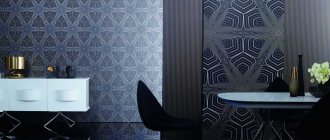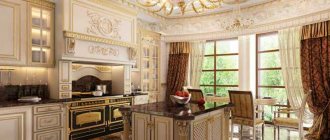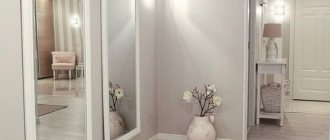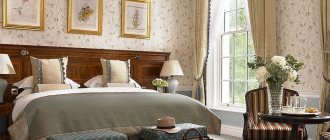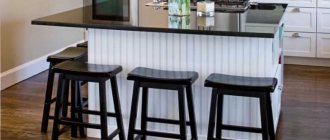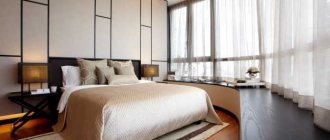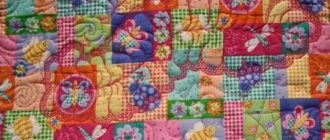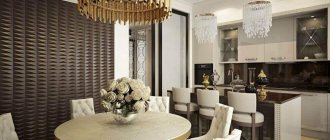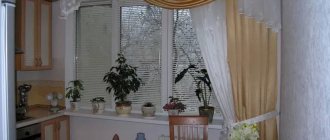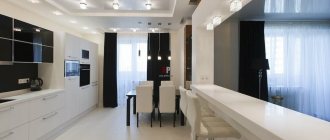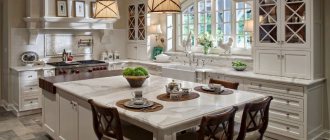Advantages and disadvantages of plastering
There are many advantages to using decorative putty in the kitchen interior, but there are also disadvantages.
Interesting! The disadvantages arise from the type of mixture, each has its own.
| Advantages | Flaws |
| Apply to different types of surfaces (iron, wood, concrete). | The mineral type of putty may develop cracks if the building being repaired does not settle. But the cracks are simply sealed. |
| After all the operations, there are no seams left and the result is a spacious room, not divided into segments. | It costs a lot (especially silicone), and if you are not a professional you will need a lot of it. |
| There is no need to carefully level the walls before plastering. It will all level out on its own, and for the Venetian, a small relief is even welcome. | Mineral putty can only be painted in a snow-white shade. |
| The composition allows the walls to “breathe” due to the free movement of air. | Acrylic putty should not be applied over slabs because toxic substances may be released. |
| If the recipe contains minerals, then they do not allow mold, bacteria and fungi to multiply. | Before using the silicate type, it is necessary to prime the walls with a special solution using a complex technique. |
| Long service life and strong resistance to various negative influences. | |
| Ease of restoration. If a small part is damaged, there is no need to putty the entire surface again. |
Despite the large number of disadvantages, there are many more advantages. An additional advantage is its relevance in different designs, which is why it is in demand in kitchen decoration.
Do-it-yourself decorative plaster in the kitchen, application tips
Methods for applying any solution are carried out according to one method, and the difference in the pattern is created by certain manipulations of the tool. Of course, it is better for a professional to do this, but if you decide to try it yourself, you will have to learn some of the intricacies of the material application technology.
Example of applying silicone mixture
The mixture is sold in ready-made liquid form, which does not require additional intervention, in colored and colorless versions. White solutions are additionally tinted to suit your own taste. It is a textured variety, and such solutions are applied in thin multiple layers, with a thickness of 1.5 mm. and less.
- The first thing we do is measure the area of the walls being treated; the solution has a preliminary estimated calculation in the instructions.
- We prepare the surface by cleaning it from dust and other contaminants, cover all cracks and depressions on the wall, this can be done with special silicone putty, putty, etc.
- Primer treatment will be an additional and mandatory element for better bonding of the coating; there is a special solution of primer, deep penetration, for application to the base before applying the silicone mixture.
- Application begins from the corners to the center, using a construction trowel, we spread the solution on the wall, the direction of rubbing is determined by the pattern being applied. The tool angle is minimal. The thickness of the layer depends on the type of solution and the desired effect. When designing a picture, we also use special relief applicators, a rubber roller, etc.
- If the mixture is of the bark beetle type, then apply a layer no larger than the diameter of the decorating particles, wait for it to dry, and then re-apply the next one. The direction of the stripes depends on the direction of movement of the tool. Level using a rule and a spatula.
Application technology, video
- In the case of a smooth silicone mixture, apply the solution with a spatula, creating a smooth surface, leveling it like regular plaster.
- The texture of the world map is applied in two layers, the first one is even, after drying we apply it again, this time structurally, distributing it in islands. Let it dry a little, then using a trowel, without strong pressure, rub it to create a texture. After ten minutes, we go through it again with a spatula, smoothing the surface.
- The final stage can be treated with a special finishing varnish. Decorative plaster world map is a common texture in the kitchen due to its aesthetic appearance and pattern structure.
Also read: What are 3D panels?
Different types of textures can be created with different structural rollers, embodying a variety of relief types. The most difficult work is creating the correct desired pattern or relief; it is advisable to understand this issue in more detail by consulting with masters and watching video tutorials.
Decorative plaster for a small kitchen is more suitable with a smooth structure and light colors, or with a pattern that will create the effect of visually enlarging the room.
Apron made of decorative plaster in the kitchen
On walls in areas of intensive use, when creating an apron, you can use different materials from tiles to decorative plaster, combining them, etc. Plaster is used by many finishers, and it has proven to be practical, earning positive reviews.
When working with the mixture, in places such as the hob and near sinks, the surface can be additionally treated with a special varnish and wax, which will provide additional protection against grease, dirt and water.
It is better to create a smooth surface; a textured texture will collect more dirt and, over time, ruin the cladding. For example, a mixture imitating concrete, marble, granite is suitable; they are often used in aprons and work areas in the kitchen.
Decorative plaster in the kitchen interior is becoming increasingly popular due to its resistance to external influences. A reliable way to decorate walls that require enhanced properties.
Apron in the kitchen, video
They also apply special tempered glass on top of the plaster mortars, in place of the apron, completely covering the wall with glass. Creates an interesting modern appearance.
Remember that decorative plaster is difficult to dismantle; this process is labor-intensive; it is removed with a grinder and a hammer drill. It is necessary to take into account in advance all possible defects that may appear during operation.
Selecting the palette and textures
Decorative plaster for interior wall decoration is selected depending on the volume of the room. The larger it is, the more texture and relief is allowed. There will be no difficulties in choosing the right color, because there are approximately 2000 shades of colors. The colors can be selected from a catalog or in a store with a consultant to match the tone of the set, dining table, chairs, curtains, etc.
The mixture is produced in two consistencies: powder and paste. The dry powder is diluted in water to the required consistency immediately before puttying. Once the mixture has hardened, it cannot be diluted, so do not dilute it too much. Ready-made pastes are sold in sealed containers, so they are not afraid of rapid hardening. But after opening, if stored improperly, the solution may harden, so it is better to use it immediately without any residue.
The most popular color for kitchen decoration is snow-white. It is used in many styles. With it you can get brickwork suitable for the Scandinavian style.
Beige is also often used for decoration. Venetian plastering can be used to create a classic or neoclassical kitchen apron.
For bright new styles, a green tone is suitable. It is not necessary to plaster the entire area with it. It is enough to focus, for example, on the dining area.
Violet, pink and lilac colors can create a more relaxed and gentle atmosphere in spacious rooms.
Charcoal decorative plaster for the kitchen is used for high-tech, minimalism, loft. Moreover, the walls should be smooth or with slight relief.
Grayish shades are used for minimalism, high-tech, modern and loft.
Blue and turquoise tones are suitable for Provence, country, and Mediterranean style. They go well with white shades and small floral prints.
The rest of the bright colors are carefully selected so that the furniture and decor look harmonious.
The stucco molding and frescoes look very stylish. But it is very difficult to obtain them on your own. That's why it is prescribed to masters.
Peculiarities of work - expert advice
To ensure that working with decorative solutions does not seem very complicated, you need to take into account some nuances:
- It is necessary to prepare the walls as best as possible for puttying. A smooth finish will not work on very textured walls. And some textured putties will also not fit as they should.
- Plastering is more expensive than wallpapering or painting. Therefore, take this into account when planning your renovation. Always be prepared that you may need a new portion.
- Textured designs and deep reliefs require more material compared to smooth surfaces. This also needs to be taken into account when planning repairs. For example, acrylic type is required for 1 sq.m. on average from 2.5 kg. up to 3kg. But each manufacturer has different recommendations, you need to rely on the instructions.
- To save on putty, you can choose a primer mixture with deep penetration. But it is necessary to look for compatible ones so that the work does not crumble or become deformed. This primer will additionally protect against mold and fungi, because it contains a fungicide and an antiseptic.
- For distribution, you can use any movements (long, short, crosswise, longitudinally, smoothly, roughly). You can even roll it out with a tool in different directions or with gloved hands. To get the same effect, 1 person must distribute everything in the room.
- The solution will harden within 2 weeks. And until it dries completely, you need to be extremely careful so as not to spoil the plastering.
- Due to the rapid hardening, quick work is required, so it is better to do everything together. For example, the first will apply, and the second will distribute and create relief.
- To maintain a pleasant appearance for a long time, everything is treated with acrylic varnishes or protective wax. They increase service life, prevent cracking, make the surface more resistant to moisture, and make the coating shiny, emphasizing the relief.
Which decorative plaster to choose for the kitchen?
And so we will analyze the types of applied fabric according to the composition of the material filling. There are 4 main types. The basis of the chemical composition and binder determines the technical characteristics, scope of application and method of application.
Varieties by composition
Mineral. Made on the basis of gypsum, cement, lime, clay with the addition of decorative elements, such as sand, granite, marble powder and many other fillers, synthetic or natural. It is used for both internal and external wall cladding. Solutions can be in different compositions, individual components or combined, with a predominance of one or another component.
- A mixture containing gypsum. Some subspecies are not recommended when using facade finishing and in rooms with high humidity, such as kitchens and bathrooms.
- The bulk of the solutions are formed on a gypsum basis and it is the most common. To increase its technical properties, various additives are added in the form of antiseptics and hydrophobic fillers. Due to this, it is widely used in rooms with a high moisture threshold.
- The cement-based material is quite resistant to moisture, and is often used in kitchens, but it is not entirely a decorative material. Typically, cement acts as an additional filler, affecting its character.
Silicate. The main composition contains liquid glass. In addition to facade decoration, it is also used for interior wall cladding. The most durable and strong material of all presented. Has a high price.
Acrylic or polymer. This variety is often found in the decoration of kitchen rooms. Produced on the basis of epoxy and acrylic resins, polyurethane. This plaster is durable, flexible, and copes well with aggressive climates.
Silicone. Applicable in all rooms, kitchens, baths, and also suitable for external walls. The base contains synthetic resin. Quite flexible and durable material. Sold ready-made, easy to use, but has a high price.
Many construction experts do not recommend using gypsum-based decorating mixture in wet rooms, and opinions on this issue are divided. In practice, there are cases when the kitchen is finished with decorative plaster based on gypsum, and there are positive responses.
- According to the main characteristics, any decorative plaster is suitable for framing walls in the kitchen; each composition makes the material sufficiently durable and moisture-resistant. The most common are acrylic, gypsum and lime masses.
- For example, to cover areas of the apron or dining area, it is better to choose smooth textures; in areas of low abrasion of the surface, it is permissible to lay any desired patterns. This is due to the possibility of easy maintenance, and if the surface is smooth, then it absorbs dirt much less and is much easier to clean.
Today, many people use simple gypsum plasters, for example, by mixing the finishing and starting mixtures, then diluting them with color, creating solutions that can decoratively decorate walls. To increase moisture resistance, when diluting the dry mixture, acrylic primers are added in place of the water. In this way, the technical characteristics of the material are significantly increased, making it possible to finish the walls in the kitchen. After the work is done, it is covered with varnish, wax or the same primer. The result is a decorative surface for a small investment.
The construction market offers mixtures designed specifically for kitchens.
Also read: Modern building materials for walls
Types of texture
It is divided into two main types, these are structural and textured solutions. Further, the names are determined by the external effect and relief of the canvas.
- Structural plaster. (bark beetle, fur coat, lamb and other structural formations)
- Textured mixture. (imitation velvet, leather, wood, silk, porcelain stoneware, world map, Venetian, travertine, sea breeze, concrete, gold, metal and other texture options)
- Flock. (silk and cellulose are added as a decorative element) Know-how from the manufacturers; after application, fibers are sprayed, creating an interesting silk surface.
- Venetian surface. (more often it looks like marble, contains marble dust) other imitations of stone are also possible.
- Smooth texture. (flat surface, usually colored masses with different outlines)
- Sgraffito. (drawings, inscriptions, etc.) Using stencils or by hand, a convex relief is created; here the name implies the creation of a relief ornament.
Choose the appearance of the future surface according to your preferences. With a variety of color palettes and a wide range of different looks, decorative plaster walls in the kitchen will create a beautiful look with a unique design. In addition, it is possible to set an individual look using various tools to create relief.
Manufacturers offer a large selection of textures, each time adding new options both in composition and in appearance. This article presents only a few types.
Varieties, video
Characteristics
Decorative plaster is a universal material suitable for all types of premises; it is also widely used for external decoration. Like any type of finish, any coating has its advantages and disadvantages.
Minuses
- High cost, the material itself is more expensive than ordinary plaster. And it is advisable to carry out the work by the hands of a professional, especially when creating relief images. Applying highly paid labor.
- When the building shrinks, cracks may appear in some varieties; in new houses it is better to refuse and wait a while.
- Installation involves a labor-intensive, time-consuming and dusty process. After application it takes a long time to dry, from 2 to 7 days.
- Difficult dismantling. The coating is difficult to remove, as it is very firmly connected to the wall, which creates difficulties when repairing and replacing the coating.
Also read: How to fill empty walls
pros
- Thanks to antiseptic additives it is protected from fungus and mold.
- Positive performance characteristics include resistance to external physical damage, does not accumulate dust, are not affected by moisture, and does not absorb odors. Easy to clean and wipe clean.
- Lays on any surface, concrete, brick, wood, metal, adheres well and does not peel off.
- A smooth, seamless monolithic surface is created. It has excellent aesthetic qualities and makes it possible to create various attractive images of any complexity. Noble appearance and unique design.
- Decorative plaster instead of tiles in the kitchen, as a new and alternative way of decorating walls, which is increasingly gaining popularity. This surface is in no way inferior to ceramic tiles, and in some versions it looks much more interesting.
The best photos of real examples
In order to choose the most beautiful plastering, look at examples of real photos in the interior:
